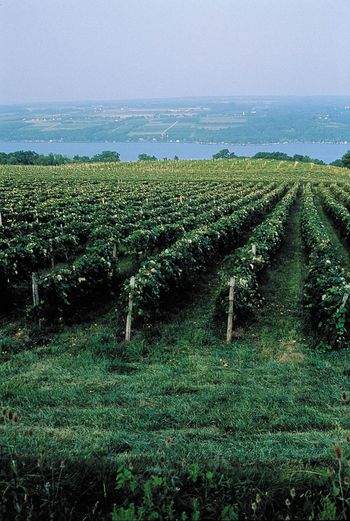By Evan Dawson
 Winemakers love to tell you that wine is made in the vineyard. Sometimes it's schlock. Sometimes it's humility. Often it's true.
Winemakers love to tell you that wine is made in the vineyard. Sometimes it's schlock. Sometimes it's humility. Often it's true.
But in vintages like 2009, when the vineyard has been challenged, wine is also made in the winery. And there are some wonderful surprises beginning to surface.
That doesn't mean it was a vintage that demanded a heavy hand for manipulation. It just means that common decisions took on more gravity in 2009. The thoughtful winemakers are seeing it pay off.
We can begin with the understanding that 2009 in the Finger Lakes was a complex vintage, challenging indeed, but one thing it decidedly was not was very ripe. A very cool spring led into a very cool summer, and ripening was miles behind a normal pace come September. But September saved the vintage, with warm and dry days. The cool climate varieties had a chance to thrive.
Acids were still extremely high, and John McGregor of McGregor Vineyard on Keuka Lake predicted it would be "an acid lover's year." By the time his crews brought in the rielsing, McGregor had formed a plan to handle the acid.
"We're going to adapt and leave more sugar than we often do," McGregor told me at the time. "This is a vintage for acid freaks across the board, and I'm in that category. But I also want this to be a vintage for riesling lovers, and it still can be."
It seemed like wishful thinking at the time, but McGregor is proving prophetic. In fact, there's another benefit of a high-acid year like 2009: The wines have an excellent opportunity to age gracefully and even improve with time in the bottle. That natural backbone will stand strong for a long time, unlike many 2007 Finger Lakes rieslings, which are already showing the early signs of age. Recent tastings of 2007 rielsings from Hosmer, Anthony Road, and Red Newt showed well-made wines that are built for shorter term drinking. They're not faded, but many 2007s have shed a bit of zip.
That won't be a problem for the 2009 vintage, and if winemakers figured out a way to turn out balanced rieslings, there is tremendous potential ahead. I've heard some winemakers say that 2009 was a "semi-dry kind of vintage," meaning the extra sugar in a semi-dry riesling can handle the high natural acid. But the dry rieslings are showing stunning mouthfeel, balance, and nerve. Beyond McGregor, here are several more wineries that made some changes to handle the acid and produce excellent riesling.
Billsboro Winery 2009 Dry Riesling and Atwater Estate Vineyards 2009 Dry Riesling
I headed to Billsboro Winery to try their 2009 Semi-Dry Riesling; their '08 semi-dry earned the honor of NYCR White Wine of the Year for 2009. Naturally I was eager to taste the encore.
But the newest edition is almost flabby. It's the Billsboro 2009 Dry Riesling that truly impressed. This is a wine with a foundation of stone, like a shale formation in the Ithaca gorge, on which it hangs an impressive amount of fruit.
The Atwater 2009 Dry Riesling might be even more expressive, with that same familiar crunchy core and layers viscous peach and lime pie. Winemaker Vinny Aliperti, who made both, explained how he approached such a high-acid vintage.
"We are pleased with '09," he said. "They needed a bit more residual sugar than normal. The high acid and low pH might provide some real ageability. I arrested fermentation in these wines, just as I did in the 2008 rieslings. And that's a practice I intend to continue."
Hosmer 2009 Dry Riesling
Two little grams of sugar made the difference for winemaker Aaron Roisen. "We typically let the Dry Riesling settle out at seven grams of residual sugar," he told me. "But it was on a narrow little edge there, and I wanted to keep the wine balanced. So that's how we dealt with the acid."
It has worked out beautifully. The Hosmer 2009 is a wine with cut and length, a difficult combination to achieve. You might have read last week that Tunker Hosmer called 2009 a "fooler vintage," with challenges but extremely high potential for strong producers.
Roisen went further, explaining that he finds there to be a sweetness level in Finger Lakes riesling where the ageability begins to break down. "Twenty grams," he said, or 2.0% RS. "Beyond that, and I think it picks up balance issues for the long haul. Some of our semi-dry rieslings are higher than twenty grams, and sometimes you need that for balance. But to get a real long-haul rielsing, I like it right there at twenty grams or less."
It's an interesting observation, but on this point, I disagree with Roisen. One of the great Finger Lakes wines I've ever had is a 1999 late harvest riesling, and it is sailing along with marvelous grace.
Conclusions
More than most vintages, 2009 is one in which consumers ought to take real care in learning about the vineyard management, winemaking approach, and producer philosophy. There will be some severe wines, some off-balance offerings. But when it comes to 2009 Finger Lakes rieslings, winemakers and the growing list of excellent growers showed a delicate hand in producing something special. And years from now, there's a good chance that the best of them will be special still.
